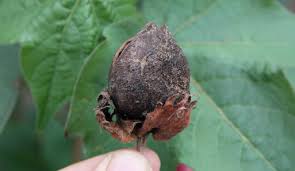
Boll Rot of Cotton
Diplodia boll rot
Diplodia boll rot starts as dark brown lesions which rapidly expand to cover the whole boll as the rot progresses. In the later stages of development, bolls become covered with a black smut-like fungal growth which can easily be rubbed off the boll surface. Several other fungi can cause secondary boll rots in cotton, taking advantage of injury or wounds in the boll wall, often caused by insect pests.
Fusarium boll rot
Not to be confused with Fusarium wilt, Fusarium boll rot causes similar boll rots to Phytophthora, with mould sometimes having a pink discolouration.
Sclerotinia Boll Rot
Sclerotinia boll rot characteristically has black fungal structures (2 to 10mm diameter) within and/or on the surface of the rotted bolls. A white cottony fungal growth may be present and the branch adjacent to the boll may also be affected. The sclerotinia germinate to produce apothecia (small cream coloured ‘golf tees’) which release clouds of microscopic spores that can only infect the plant thorough dead or dying tissue (e.g. flower petals). The fungus then grows into healthy plant tissue such as the developing boll and down the fruiting branch towards the main stem. Hosts include sunflower, safflower, soybean and most pasture legumes.
Favoured by
• Boll rots are favoured by wet and humid conditions, especially from a thick rank canopy and high moisture from rains and dews.
• Rainfall on exposed soil that splashes soil up onto low bolls enables infection for some boll rots. Low mature bolls and lodged plants are at high risk of infection.
• Boll rots and tight locks can also develop when bolls that are opening are exposed to wet weather.
High numbers of sucking pests soon after flowering can increase the likelihood of seed rots
Control strategy
PLANNING
• Field drainage should not allow water to back-up into the field and inundate low bolls on plants near the tail drain.
PLANTING
• Avoid very low plant populations which result in exposed soil that can be splashed up onto low bolls at the end of the season.
IN CROP
• Avoid rank growth and a dense crop canopy if possible.
• Assess incidence prior to or after defoliation by counting all of the bolls on ten plants from each of ten randomly selected sites across the field. Counts should not be confined to areas near the tail drain as this may give a misleading result.
AFTER HARVEST
• Thoroughly incorporate crop residues as soon as possible.
AT ALL TIMES
• Practice good farm hygiene and Come Clean Go Clean.


